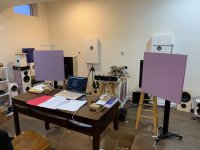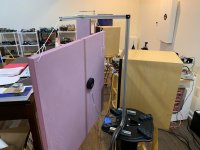You had (have?) two configs? I'm more interested in the London or UK setup and how you think that compares to the French setup. having the panels near to a wall and reaping most of the benefits would be ideal.
I have a pair of Dayton FHE 25s looking for an application. Currently thinking about 6'x2' vertical panels with a slight bow. Ha, should it bow outwards at the top/bottom or inwards?
Hi Jerms,
The French DML's have a lot of room behind them, 3.5 meters, and have a soundstage you can literally walk into. You are not going to get that with a panel close to the wall.
However, the soundstage of the London system is no slouch and in my experience better than I get with my reference which is a pair of Bowers and Wilkins CM1's.
The London DML's are 610x1200mm 3mm think Beech Ply 'Laserboard' hung horizontally. This is the same dimension as the French panels, but they are hung vertical orientation. I don't think the orientation is important. Both sets of panels have corner radii of circa 100mm/ 4inch.
The London panels are hung 160mm or 6inches away from the back wall. Both panels have the rear surface coated with 25mm/1inch of loudspeaker stuffing, a fine nylon fibre mat which I stuck lightly to the surface using spray adhesive. Before I did this I had a nasty colouration caused by early reflection from the back wall. The absorption layer did the trick and the response is now pretty flat.
The London panels produce a very good soundstage. As with the French panels the soundstage is behind the panels, not in front. Instrument and vocal positioning is sharply defined. Listening to opera you get a very clear depiction of the orchestra in front of and below the singers. It is easy to position the string instruments, cellos and viola on the right, first and second violins on the left, woodwind in the middle and brass behind them. Where they differ from the French panels is that the depth presentation is very good, better than the CM1's, but without the holographic sensation you get from the French setup which is a remarkable effect. In the French setup you can walk into the soundstage up to Tom Wait's piano, or stand beside London Grammer's Hannah Reid and no that is not an exaggeration. I think it would be possible to close the gap between the two by moving the London panels out further but I can't do that, (just a side thought- if you can stand mount your panels and bring them out into the room for playing then that might work very well). Play London Grammer on the London panels and Hannah is clearly there, about three or four feet behind the wall, which is an odd sensation at first, but very well defined. Tom's piano is similarly well defined behind the panels but easily 'seen' and the right scale. I often play music with the lights out and when I do in London some of the French soundstage magic returns so for me there is a psychological effect at play here as well, my brain won't accept too much depth when I can see there is a wall there. You may not have this problem. In the dark the soundstage expands and is more immersive.
So in summary, you can get close to the full scale holography of the French panels with panels close to a back wall, but you will need that absorption layer on the back which is cheap and quick to do.
Thanks for the question, I hope this helps.
Burnt
Last edited:
Nice to hear that you are listening to the beautifully voiced Hannah Reid. She has an extraordinary range. Can’t wait for another new album to see how they develop. There must be one in the making.
Hannah has a wonderful voice doesn’t she. Good news on the next album, it’s about to be launched according to their website. I am looking forward to it as well.
A couple questions for you engineers out there.
1. Can someone explain how to find the fundemental resonant frequency of a panel (either via an equation or by a simple measurement technique).
2. Does the fundemental resonant freq of a panel change in a linear way with the panels size? For instance, if I have a 10" x 20" rectangular panel with a fundemental resonant frquency of 100 Hz. If I then double the dimensions to 20" x 40" does that halve the fundemental resonant freq of the bigger panel to 50 Hz? (all other panel factors being equal)
In the piston driver world you need smaller diameter drivers for higher freq's. In the DML world larger panels are actually better for HF's . The reason being that the larger panel supports more modal points, which evens out the FR. The HF already creates a large number of modal points and making the panel larger simply enhances that. Obviously, larger panels also enhance the Mid and Bass as well.
You have it back wards. DML panels operate similarly as conventional cone speakers when it comes to size as its just physics. Smaller panels have better HF while larger panels have more LF.
Ideal size for a certain frequency. (approx.)
1-2inch=tweeter= around 2000khz and up
3-4inch=midrange= around 300hz and up
5-6inch=mid bass woofer= around 70hz and up
7-8inch= woofer= around 40hz and up
10inch and up= sub woofer=anything below 40hz.
Since exciters are limited in there pistonic motion most exciters wont go lower then 50hz and that is usually at very low spl levels. Norm range for most exciters is 70hz-100hz and up. I don't have equations but to reach the exciters full bass extension limit the panel needs to be at least 15-16inches and or to be safe 2ft. After 2ft. the LFE does not increase. This is the reason why I say bigger is not always better. There is a right size panel for the right size or right amount of exciters. The exciter needs to saturate the panels. Small exciters wont saturate big panels as there vibrations are just not strong enough while larger exciters can over saturate a small panel.
Physics dictates that larger diaphragm area equals more bass but reduced highs. While smaller diaphragm area equals more highs but reduced bass. Its no different when it comes to DML's.
First thing I tried today was to make some MakerBeam cantilever stands to elevate the panels to ear height. That made a huge difference in sound stage. Very wide and spacious now - kind of nice "you are there" feeling. I might round the corners next - they definitely feel like the vibration aplitude at the corners is the highest and so rounding them might force more of the energy back to the center of the panel where it will do more good.
Shot of the lab with both DML's visible - height is about same as my reference 10F/RS225 speakers now. Cable moved off the panel and onto the stand:
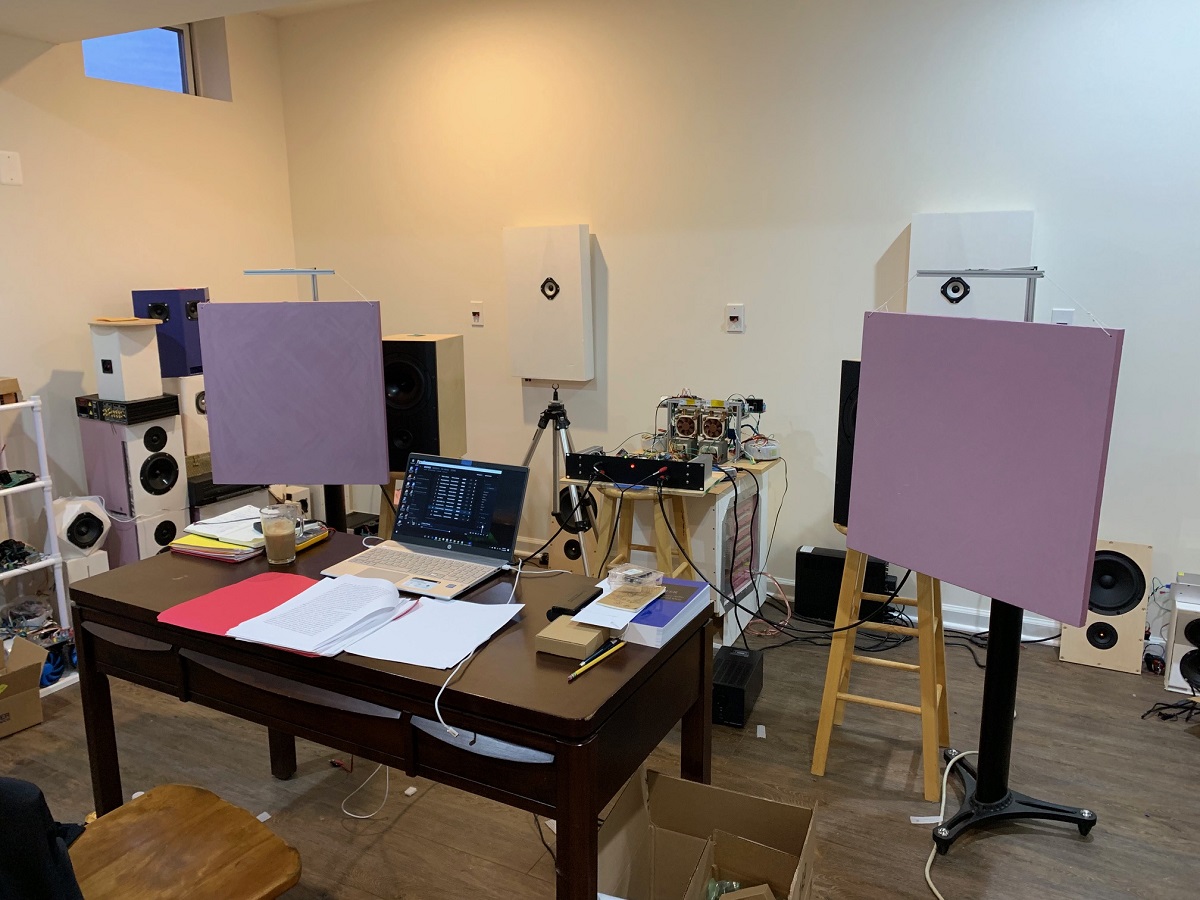
Here is detail of the MakerBeam stands:
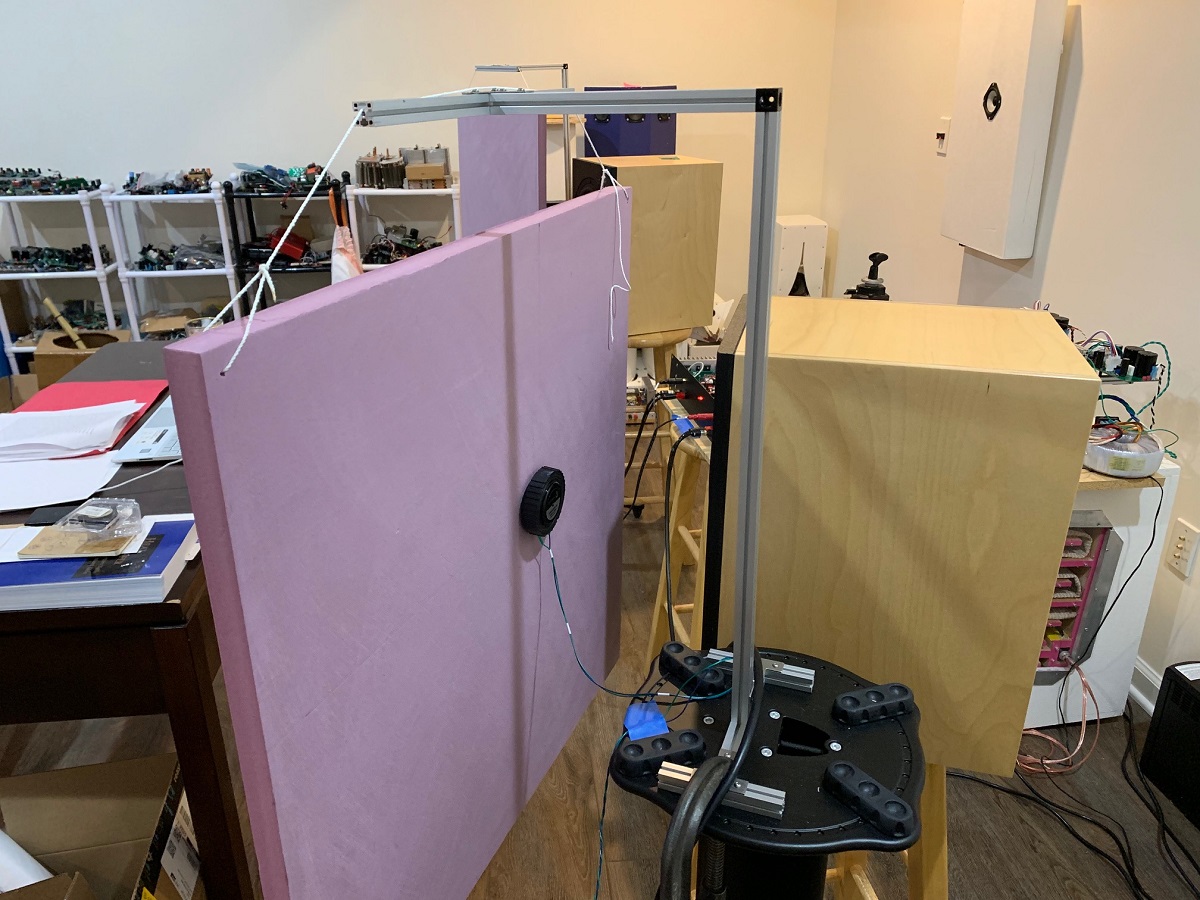
Shot of the lab with both DML's visible - height is about same as my reference 10F/RS225 speakers now. Cable moved off the panel and onto the stand:
Here is detail of the MakerBeam stands:
Attachments
Last edited:
I've used heavy litz wire to connect between exciter and external gear. You can drape it and because it hangs limp it doesn't interfere with the exciter as ordinary wire will. I got it via an ebay seller of surplus wire.
I just added my horn loaded sub woofer, crossover circa 80hz to 100Hz and it really makes a huge difference. Listening to the Who's "See Me Feel Me" - very nice. One of my favorite songs on the DML's so far.
You have it back wards. DML panels operate similarly as conventional cone speakers when it comes to size as its just physics. Smaller panels have better HF while larger panels have more LF.
Ideal size for a certain frequency. (approx.)
1-2inch=tweeter= around 2000khz and up
3-4inch=midrange= around 300hz and up
5-6inch=mid bass woofer= around 70hz and up
7-8inch= woofer= around 40hz and up
10inch and up= sub woofer=anything below 40hz.
Since exciters are limited in there pistonic motion most exciters wont go lower then 50hz and that is usually at very low spl levels. Norm range for most exciters is 70hz-100hz and up. I don't have equations but to reach the exciters full bass extension limit the panel needs to be at least 15-16inches and or to be safe 2ft. After 2ft. the LFE does not increase. This is the reason why I say bigger is not always better. There is a right size panel for the right size or right amount of exciters. The exciter needs to saturate the panels. Small exciters wont saturate big panels as there vibrations are just not strong enough while larger exciters can over saturate a small panel.
Physics dictates that larger diaphragm area equals more bass but reduced highs. While smaller diaphragm area equals more highs but reduced bass. Its no different when it comes to DML's.
You seem to have mashed together 2 different posts of mine. However, you are wrong concerning the physical behavior of HF transverse waves across a DML vs pistonic motion of a cone.
Here's an explanation from Henry Azima, PhD, of NXT fame:
[SIZE=-1][FONT=Verdana, Arial, Helvetica, sans-serif]:[/FONT][/SIZE]
[FONT=Verdana, Arial, Helvetica, sans-serif][SIZE=-1] An NXT panel closely approximates a randomly vibrating diaphragm, and so behaves similarly. Distributed Mode operation is therefore ideal for a loudspeaker: it guarantees consistent output level and undistorted time response in all directions. In other words, all the radiated energy appears to originate from a single point. Despite this the DML is able to produce high broadband acoustic power because its diaphragm is not size constrained. With pistonic diaphragm motion, these characteristics are mutually exclusive.[/SIZE][/FONT]
[FONT=Verdana, Arial, Helvetica, sans-serif][SIZE=-1]
[/SIZE][/FONT]
[FONT=Verdana, Arial, Helvetica, sans-serif][SIZE=-1] There are also numerous spin-off benefits to a DML loudspeaker. As well asbeing insensitive to diaphragm size, the acoustic behaviour (other than sensitivity) is unaffected by diaphragm mass. In a conventional diaphragm, moving mass determines the upper limit of the frequency response - another reason why tweeters must be small. With an NXT panel there is no equivalent restriction, so the technology is truly scaleable: you can make the panel large without directivity or treble response suffering. In fact it actually improves in performance as it is increased in size because the frequency of the fundamental bending resonance is lowered, which not only extends the bass response, but also increases modal density in the mid and high frequencies."[/SIZE][/FONT]
You seem to have mashed together 2 different posts of mine. However, you are wrong concerning the physical behavior of HF transverse waves across a DML vs pistonic motion of a cone.
Here's an explanation from Henry Azima, PhD, of NXT fame:
[SIZE=-1][FONT=Verdana, Arial, Helvetica, sans-serif]:[/FONT][/SIZE]
[FONT=Verdana, Arial, Helvetica, sans-serif][SIZE=-1] An NXT panel closely approximates a randomly vibrating diaphragm, and so behaves similarly. Distributed Mode operation is therefore ideal for a loudspeaker: it guarantees consistent output level and undistorted time response in all directions. In other words, all the radiated energy appears to originate from a single point. Despite this the DML is able to produce high broadband acoustic power because its diaphragm is not size constrained. With pistonic diaphragm motion, these characteristics are mutually exclusive.[/SIZE][/FONT]
[FONT=Verdana, Arial, Helvetica, sans-serif][SIZE=-1]
[/SIZE][/FONT]
[FONT=Verdana, Arial, Helvetica, sans-serif][SIZE=-1] There are also numerous spin-off benefits to a DML loudspeaker. As well asbeing insensitive to diaphragm size, the acoustic behaviour (other than sensitivity) is unaffected by diaphragm mass. In a conventional diaphragm, moving mass determines the upper limit of the frequency response - another reason why tweeters must be small. With an NXT panel there is no equivalent restriction, so the technology is truly scaleable: you can make the panel large without directivity or treble response suffering. In fact it actually improves in performance as it is increased in size because the frequency of the fundamental bending resonance is lowered, which not only extends the bass response, but also increases modal density in the mid and high frequencies."[/SIZE][/FONT]
Why I am wrong? Because that guy has a phd so he is right? LMAO Aight man I aint going to convince you believe what ever you want.
First thing I tried today was to make some MakerBeam cantilever stands to elevate the panels to ear height. That made a huge difference in sound stage. Very wide and spacious now - kind of nice "you are there" feeling. I might round the corners next - they definitely feel like the vibration aplitude at the corners is the highest and so rounding them might force more of the energy back to the center of the panel where it will do more good.
Shot of the lab with both DML's visible - height is about same as my reference 10F/RS225 speakers now. Cable moved off the panel and onto the stand:
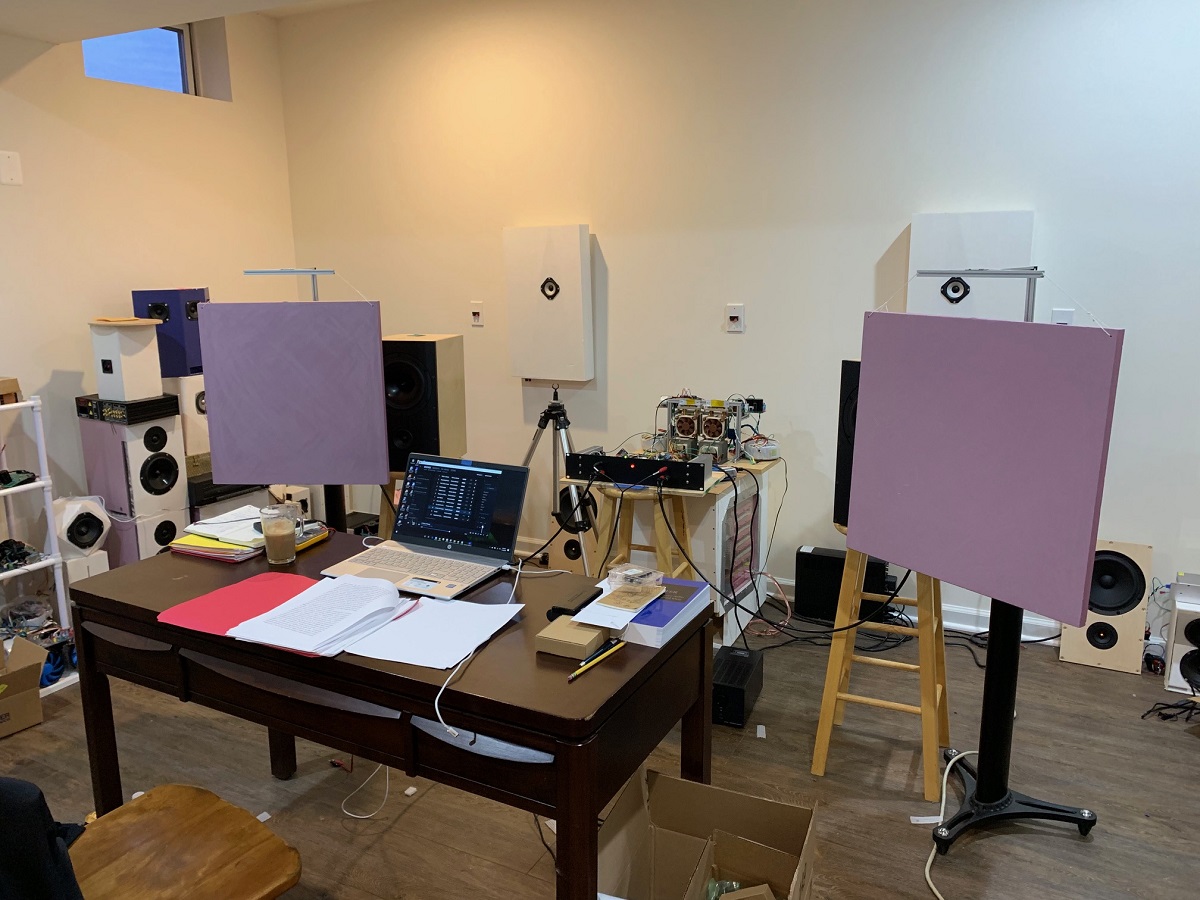
Here is detail of the MakerBeam stands:
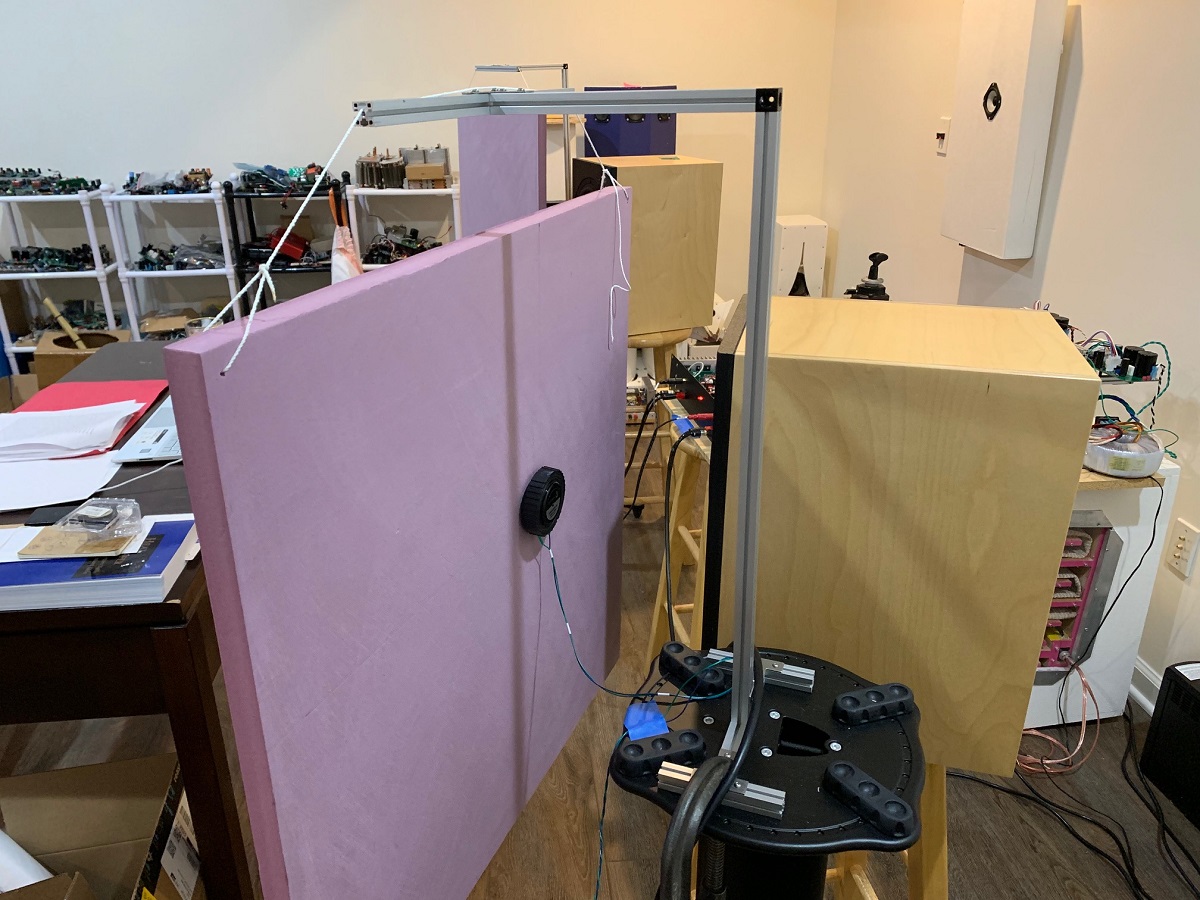
DML placement is similar to conventional cone speakers where they should be around ear level. Even toe ins can make a difference.
I think I can help here and no PhD is required. There is a simple test to verify that high frequencies are evenly distributed across a large panel. You can hear them. If you keep the volume at a reasonable level to protect your hearing and put you ear close to the surface you will find there is no difference in high frequency output across the entire surface. If DML’s acted like conventional drivers you would not find this happening. Try the same with a large cone driver, e.g. 12 inch, high frequency output is higher at the centre of the cone. Similarly with ESLs the high frequencies ‘beamed’ from the panel in a tight region rather than be spread over the diaphragm evenly. That’s why a lot of work has been done to ameliorate this effect the most noticeable being Martin Logan’s curved diaphragms.
I think I can help here and no PhD is required. There is a simple test to verify that high frequencies are evenly distributed across a large panel. You can hear them. If you keep the volume at a reasonable level to protect your hearing and put you ear close to the surface you will find there is no difference in high frequency output across the entire surface. If DML’s acted like conventional drivers you would not find this happening. Try the same with a large cone driver, e.g. 12 inch, high frequency output is higher at the centre of the cone. Similarly with ESLs the high frequencies ‘beamed’ from the panel in a tight region rather than be spread over the diaphragm evenly. That’s why a lot of work has been done to ameliorate this effect the most noticeable being Martin Logan’s curved diaphragms.
All frequencies start at the center of the voice coil and work there way outward. Frequencies are evenly distributed on a DML panel but HF become less pronounced as they reach the edges especially in larger panels. Its the same way in conventional cone speakers. The reason why you can hear it in conventional cone drivers is for the mere fact that the diaphragm is a "CONE SHAPE", therefore you can distinguish the higher frequencies better from the center because the cone shape makes it more pronounced in the center and less pronounced as the highs reach the edges especially once again in larger cone drivers. In a 2-3 inch conventional cone full range driver the diaphragm is so small its hard to distinguish the highs from the center to the edges so the highs will be more PRONOUNCED. Aluminum dust caps and whizzer cones help to increase HF and they are always in the center closest to the voice coil.
Ever wonder why a full range BMR driver is not over 3.5inches? If high frequencies are better with larger diaphragm then Tectonic would of made there BMR drivers 8",10",12"15", but they don't because they know that anything over 3 inches will start losing the high frequency response. PROOF!!!!
One of the newest professional DML designers I have seen recently is the Russian company known as "SHEET CONTROL". They seem to be on the right track. They are slowly figuring out that smaller panels have better high frequency response which is the reason for them to add a smaller panel on top of there full range speaker for better high frequency response. PROOF!!!!!
YouTube
This is the reason why smaller panels will have better HF. While larger panels will have less HF. Even Bertagni knows this is the correct method. If you look at Bertagni's speakers pics posted on here you will see a small circle around 2-3inches where the HF exciter resides as this 2-3inch circular crater will make the highs more pronounced because the high frequencies are prominent in the center out to about 3inches. This crater acts as a whizzer cone and the HF exciter is directly in the center of it. Small sizes equals better more prominent High frequencies. Larger sizes equals more bass. If Bertagni thought larger diapharagm equals better HF then he would of made the crater 10inches or larger. PROOF!!!!
My goal is not to be right, its to tell the truth so you can build better panels. But hey what do I know, if you don't believe me just follow Tech ingredients or Henry Azimas advice as they both have PHD's for creds. LMAO
Last edited:
If you put something on the membrane to make it locally inhomegenous and perhaps thinner or higher stiffness and mount the exciters there - you would expect its vibrational resonant mode to be different. Usually smaller membranes support smaller wavelengths, hence higher frequencies. Offgrid showed us the beer can bottom trick where he mounted an inverted aluminum dome from a beer can on the panel and put the exciters there. It probably acted as a local dome tweeter and the lower freq transmitted to the main panel to act as a DML for other frequencies. The beer can might be closer to pistonic but will have some breakup frequencies similar to a 3in driver.
A strange thing I noticed with XPS panels is that the highs seem more distinct on the back where the actual exciter was mounted. I wonder if that is sound emanating from the exciters body itself at the highs?
I do think you could make a multi-way DML with various sizes. A cutout near the corner to isolate a section that’s smaller and having its own DML high-passed with a cap might be interesting thing to try.
A strange thing I noticed with XPS panels is that the highs seem more distinct on the back where the actual exciter was mounted. I wonder if that is sound emanating from the exciters body itself at the highs?
I do think you could make a multi-way DML with various sizes. A cutout near the corner to isolate a section that’s smaller and having its own DML high-passed with a cap might be interesting thing to try.
Last edited:
If you put something on the membrane to make it locally inhomegenous and perhaps thinner or higher stiffness and mount the exciters there - you would expect its vibrational resonant mode to be different. Usually smaller membranes support smaller wavelengths, hence higher frequencies. Offgrid showed us the beer can bottom trick where he mounted an inverted aluminum dome from a beer can on the panel and put the exciters there. It probably acted as a local dome tweeter and the lower freq transmitted to the main panel to act as a DML for other frequencies. The beer can might be closer to pistonic but will have some breakup frequencies similar to a 3in driver.
A strange thing I noticed with XPS panels is that the highs seem more distinct on the back where the actual exciter was mounted. I wonder if that is sound emanating from the exciters body itself at the highs?
I do think you could make a multi-way DML with various sizes. A cutout near the corner to isolate a section that’s smaller and having its own DML high-passed with a cap might be interesting thing to try.
Yes you seem to be getting what I am saying.
I don't think its from the exciters body but from the back side being the first contact point of the exciters voice coil. Vibrations from the back need to penetrate its way through the panels thickness to radiate out of the front. Less penetration is needed for the back as that is where first contact is made from exciter on to the back of the panels surface. Plus any exciter with vents will radiate sound out of the vents making the highs sound more prominent.
Yes one can make a separate multi way DML panel of various sizes. Most common for DML is 2 way with HPF and LPF crossover. Panel used for high frequency should be small like around 1-3inches while the panel used as a woofer should be 16inches minimum to a maximum of 2ft. Also ideal panel thickness should be 5-10mm around 1/4-1/2inch thick.
I understand. However it remains true that when I use a tone wave generator at 1khz the output at a distance of 600mm from the exciter ( front of the panel) sounds as loud to me as over the exciter. I am not challenging anyone on anything, just reporting what I find. Its an easy test for anyone else to do.
As for the Bertagni design it is a very interesting one. When EPS foam became available in the 1960's a lot of designers experimented with it. I have a pair of KEFB139 drivers which are also flat and made from EPS. They were originally designed to be good for up to 1khz and crossed over to a ribbon driver for the rest of the range but this didn't work as well as intended and so they were relegated to bass only. The reason for this seems to be KEF was working on the pistonic model and had hoped that the structural foam would be stiff enough to prevent breakup. They didn't know about DML operation at the time and so did not optimised the motor system of the B139 to take advantage of DML principles. Instead of a stiff, low excursion system, the B139 has a soft suspension with high excursion capability.
Bertagni seems to have been much closer to understanding the DML operation as a review of his 22 patents will confirm. He started with thin wood and plastic panels and moved to EPS when that became available. But there are some significant differences between Bertagni's approach and the NXT approach. Bertagni uses crossovers to split the frequency range between drivers and panels like a conventional loudspeaker, NXT panels do not. Bertagni also varies the thickness of the EPS panel, the NXT approach does not. Bertagni varies panel size, NXT typically uses a single panel for the entire frequency range.
In practice everyone seems to be in the same space, but choosing different methods to optimise results. This is to be expected, there is a world of difference between the measurement tools available to Dr Bertagni in the 1970's and those available to NXT ( and the originators of the NXT technology) twenty years latter. Dr Bertagni was a physics professor and a very intelligent and talented designer who was well ahead of his time so all credit to him. But he does appear to have been doing things differently to the NXT approach. Both appear to be successful. I don't think its controversial to suggest there is more than one way to successfully exploit this technology.
Edited to add- the BMR technology does indeed appear to be closer to the Bertagni approach in the way it exploits varying the panel area according to frequency. All in the same family, controlled vibration in a panel rather than pistonic operation, but yet another embodiment of the basic principle.
As for the Bertagni design it is a very interesting one. When EPS foam became available in the 1960's a lot of designers experimented with it. I have a pair of KEFB139 drivers which are also flat and made from EPS. They were originally designed to be good for up to 1khz and crossed over to a ribbon driver for the rest of the range but this didn't work as well as intended and so they were relegated to bass only. The reason for this seems to be KEF was working on the pistonic model and had hoped that the structural foam would be stiff enough to prevent breakup. They didn't know about DML operation at the time and so did not optimised the motor system of the B139 to take advantage of DML principles. Instead of a stiff, low excursion system, the B139 has a soft suspension with high excursion capability.
Bertagni seems to have been much closer to understanding the DML operation as a review of his 22 patents will confirm. He started with thin wood and plastic panels and moved to EPS when that became available. But there are some significant differences between Bertagni's approach and the NXT approach. Bertagni uses crossovers to split the frequency range between drivers and panels like a conventional loudspeaker, NXT panels do not. Bertagni also varies the thickness of the EPS panel, the NXT approach does not. Bertagni varies panel size, NXT typically uses a single panel for the entire frequency range.
In practice everyone seems to be in the same space, but choosing different methods to optimise results. This is to be expected, there is a world of difference between the measurement tools available to Dr Bertagni in the 1970's and those available to NXT ( and the originators of the NXT technology) twenty years latter. Dr Bertagni was a physics professor and a very intelligent and talented designer who was well ahead of his time so all credit to him. But he does appear to have been doing things differently to the NXT approach. Both appear to be successful. I don't think its controversial to suggest there is more than one way to successfully exploit this technology.
Edited to add- the BMR technology does indeed appear to be closer to the Bertagni approach in the way it exploits varying the panel area according to frequency. All in the same family, controlled vibration in a panel rather than pistonic operation, but yet another embodiment of the basic principle.
Last edited:
Just for the hell of it I measured my panels using an iPad App. I used a 1khz tone and held the iPad a consistent 50mm or 2inches from the panel surface. As you can see from the diagram attached I took measurements at the corners, edge midpoints and exciter centres. The panels are handed.
Attachments
Loving this thread and the experimentation into this form of sound reproduction! Have any of you looked at how much of a correlation there is to HF response and the transducers inductance at 5<20Khz? I would assume the effects are the same as a traditional driver as it is effecting the raw energy being delivered. Would be curious to know.
My reasoning of asking is to find out if anyone has implemented a fixed voice coil to oppose the rising inductance in a DML design? I have seen eighteensound and JBL implement this in larger builds, and it is on my radar for my own driver design. Just adding these ideas in to all the testing going on. I understand implementing this right now would be tricky due to using finished transducers, but comparing HF results to the inductance of different manufacturer transducers could be done.
Paul
My reasoning of asking is to find out if anyone has implemented a fixed voice coil to oppose the rising inductance in a DML design? I have seen eighteensound and JBL implement this in larger builds, and it is on my radar for my own driver design. Just adding these ideas in to all the testing going on. I understand implementing this right now would be tricky due to using finished transducers, but comparing HF results to the inductance of different manufacturer transducers could be done.
Paul
Just for the hell of it I measured my panels using an iPad App. I used a 1khz tone and held the iPad a consistent 50mm or 2inches from the panel surface. As you can see from the diagram attached I took measurements at the corners, edge midpoints and exciter centres. The panels are handed.
Thats interesting how the left panel has that spl dip on the middle/left side. I wonder if maybe there is some slight deviation in panel thickness/density at that area or maybe it got slightly less sanding or pva treatment?
Yes I suspect some anomaly shifting the modes around. The panels are untreated beech ply and there are 'filler' sections on the top ply. These are used when knots in the wood drop out during manufacture. They may be having an effect as well. Plus we don't know how consistent the gluing is between plys. Then there is the natural variability of wood density as its a natural material. Also, I was measuring by hand so I am also a variable although I tried to be as accurate as I could. : )
The peaking of output in the corners probably means I need to use a larger corner radius as energy does tend to get trapped in the corners due to edge reflection compounding locally.
The peaking of output in the corners probably means I need to use a larger corner radius as energy does tend to get trapped in the corners due to edge reflection compounding locally.
I wouldn't use Bertagni as a reference. Although he was a pioneer of sorts he was undoubtedly wedded to the idea of crossovers and multiple drivers as in conventional speakers. He most likely had not investigated or discovered the full range full spectrum possibilities. I'd put most trust in the work of Azima and NXT. They carried out very detailed and in depth work and extended the knowledge by a huge amount.
- Home
- Loudspeakers
- Full Range
- A Study of DMLs as a Full Range Speaker
